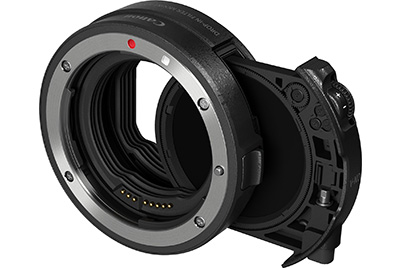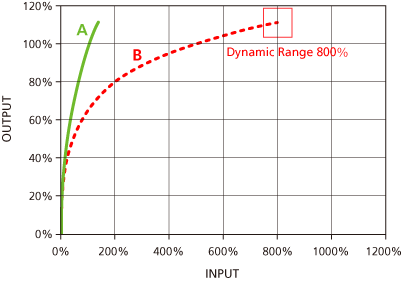4 Things You Didn’t Know About 4K Video on the EOS R
To say that the EOS R “can shoot 4K video” is in fact an understatement of its true abilities - how many of you knew that it can also be employed for serious filmmaking? In this article, we examine 4 of the EOS R’s key movie shooting specifications and what it means to the aspiring EOS R movie-maker.

1. The EOS R shoots 4K in Super 35mm format - a filmmaking industry standard
Just like how there are different still photography formats (APS-C, 35mm full-frame, medium format, etc.), there are also many different formats used in filmmaking. One of the filmmaking industry standard formats is the Super 35mm format.
The Super 35mm format shares the same origins in 35mm film stock as the still photography 35mm format. However, for historical reasons, it developed from the 35mm film stock as used in the vertical orientation (instead of horizontal orientation as in stills), hence, the different size. This does not change the fact that it is a global cinematography industry standard: Many motion pictures have been shot in this format, and the latest digital cinema cameras also come with Super 35mm-format sensors.
It is this industry standard that the “cropped 4K shooting” on the EOS R approximates. Dot-by-dot (“native”) recording ensures that the camera does not need to resize each frame, hence reducing the burden on the image processor during the recording process. This helps to prevent the camera from overheating after long hours on shooting, which in turn prevents the increased digital noise that tends to occur as a result. In addition to all that, the Super 35mm format also supports high bitrate recording, which results in higher quality images.
From all these facts, it is evident that the EOS R’s video shooting specs were developed with the real-world needs of the video production industry in mind.
2. Use the drop-in-filter mount adapter with the variable ND filter, and the EOS R transforms into a serious movie camera
In still shooting, exposure is determined by three fundamental elements: aperture, shutter speed and ISO speed. However, the case is slightly different when it comes to video shooting.
In video, the “shutter speed” you can use depends on the frame rate. At 25p/30p (25 frames per second/ 30 frames per second), the recommended shutter speed to ensure that movement looks natural is around double the frame rate (1/50th or 1/60th of a second respectively). That leaves you with only aperture and ISO speed to to manipulate freely for exposure control.
In normal indoor scenes, these would usually be sufficient. However, if you were shooting in a bright location and wanted a shallow depth-of-field, for example, you would probably not be able to achieve ideal results. In this case, you would need a neutral density (ND) filter to prevent overexposure. In fact, an ND filter is a must-have item for professional filmmaking. The fact that many high-end video cameras, including those in the Cinema EOS line-up, come with a built-in ND filter shows just how fundamentally crucial it is.
For the EOS R, there is the Drop-in Filter Mount Adapter EF-EOS R, which not only can be used with any EF lens, but also comes equipped with a variable ND filter that allows you to adjust exposure anywhere from 1 to 6 shutter speed stops. It is a brilliant answer to the needs of users keen on using a Canon still camera for videography.

Drop-in Filter Mount Adapter EF-EOS R with Drop-in Variable ND Filter A

EOS R with Drop-in Filter Mount Adapter and EF Lens
3. Canon Log: A reflection of the EOS R as a serious videography performer
The EOS R contains a number of features that benefit video post-production.
For one, it is the first EOS still camera to be pre-installed with Canon Log. Recording video with Canon Log helps to broaden the dynamic range (the difference between the lightest and darkest tones in an image). This makes it possible to reproduce a wider range of light intensities.
For example, Rec.709, the standard video gamma for HDTV, is capable of reproducing a dynamic range of up to about eight stops, and blowout tends to occur for scenes with a higher contrast ratio. In contrast, Canon Log offers a dynamic range of 12 stops, which allows more details of the same scene to be clearly retained from shadows to highlights, offering more flexibility in colour grading.

Graphical Comparison of Dynamic Range: (A) Rec.709 vs. (B) Canon Log
To take the capabilities of the EOS R even further, use an external recorder. The camera supports 4K 10-bit YCbCr:4:2:2 external recording via HDMI. This results in very high-quality output that provides abundant information, perfect for post-production.
The EOS R also comes with two broadcast standard options for colour spacing, which is necessary to ensure that colours are represented as intended across monitors and TVs:
- BT.709, which is designed for HDTV standards and is the standard used on most conventional computer and video HD monitors; and
- BT.2020, which is the standard for ultra-high definition TV (UHDTV) and is considered the colour space of the future.
These also indicate how the EOS R takes not just video shooting, but also the professional post-production workflow into account.
4. Dual Pixel CMOS AF - a powerful AF system for 4K movie shooting
i) Precise autofocusing, eliminates focus breathing
Compared to the HD and FHD video, 4K video is characterised by its higher resolution and sharper reproduction of details. However, this also means that if the image is the slightest bit out of focus, it would be even more obvious than ever before. Manual focus adjustment, too, has its limitations.
This is where the Dual Pixel CMOS AF system comes into play.
Most conventional still cameras use a combination of contrast detection and phase detection to achieve AF when shooting video. During contrast detection, the camera tends to make slight adjustments in the focal length when it tries to establish focus, resulting in what is known as focus breathing. This becomes more obvious in high-resolution 4K footage. In comparison, the Dual Pixel CMOS AF system on the EOS R performs AF using only phase detection. With this, focus stops precisely where desired, even when you are pulling focus (changing the focus during the shot).
ii) It’s already a staple on Cinema EOS
While Dual Pixel CMOS AF system has been a feature on Canon’s EOS still cameras for a while, you may be surprised to know that all Cinema EOS models are also equipped with it. In other words, the Dual Pixel CMOS AF for 4K video on the EOS R is not new. In fact, it was a pioneering AF technology for video shooting, and has already achieved a level of maturity and reliability in the field.
iii) Focus Guide to aid manual focusing
Dual Pixel CMOS AF technology is also employed in the Focus Guide feature, which provides users with a visual indicator on the focus location. This takes a huge amount of stress out of detailed focusing work, making manual focusing much easier for all users.

Dual Pixel CMOS AF
1. Photodiode A
2. Photodiode B
3. Each imaging pixel carries out both phase difference detection and imaging.

Focus Guide
Summing up
From the four aspects of the movie shooting features above, it is clear that the EOS R offers some video shooting specs that are the same as those on cinema cameras. It is also clear that Dual Pixel CMOS AF, regarded as the next-generation AF system, is a proven and reliable technology for video in addition to stills. So don’t limit yourself to shooting stills on the EOS R - make the best of its video capabilities too!
New to filmmaking? Check out this series of tutorials starting from:
Introduction to Filmmaking on Your Canon EOS (1): What Every Beginner Must Know
Click here to learn more about the EOS R
Receive the latest update on photography news, tips and tricks.
Be part of the SNAPSHOT Community.
Sign Up Now!

































